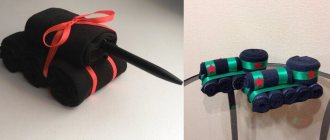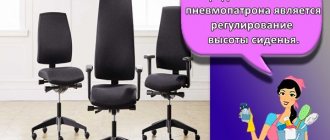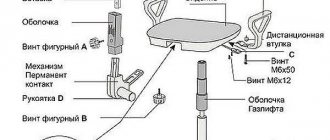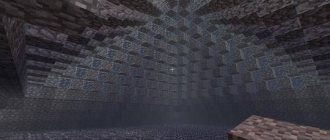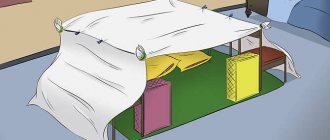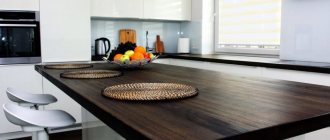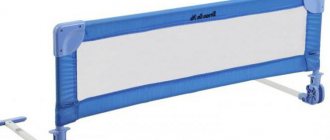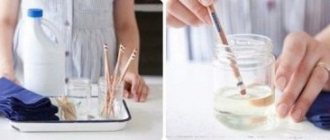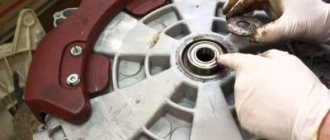Cocoon design
By using a sleep cocoon, newborns will feel more protected and adapt to their environment faster. A newborn baby does not feel well in an open, free space, but the nest gives him the usual feeling of peace.
The child must constantly feel something soft around him, which is why the cocoon itself and its sides are very soft and completely safe for the baby. The nest must meet the criteria for children's products.
It turns out that making a nest for newborns with your own hands is quite simple, it all depends on the model you choose.
How to sew a cocoon for a newborn with a zipper
Diapers with a zipper are a very convenient and necessary accessory. This diaper helps to swaddle a baby in a couple of seconds. In this case, the baby will definitely not get out of the cocoon, since he will hardly be able to unfasten the zipper.
Ideally, it would be possible to take measurements of the baby so that the zippered diaper fits. It must be remembered that its purpose is to create the illusion of a protected space in the child, and not to tightly fetter movements. The size must be selected in such a way that the baby can move his arms and legs, and the blood flow is not disturbed.
These products are sewn from soft cotton fabric, for example, a cooler
To sew a diaper, you will need the following materials:
- Knitted cotton fabric – 1 meter.
- Zipper – 1 pc.
- Threads of a suitable color.
- Paper for drawing a pattern.
- Chalk.
- Scissors.
- Button clasp – 1 pc.
Pattern:
The diaper according to this pattern is suitable for a baby from birth to 2-3 months. The pattern is given taking into account seam allowances
- You need to transfer the pattern onto paper in full size and cut it out.
- Then the fabric is folded in half, right side inward. The pattern is transferred to the fabric using chalk. You should end up with two parts.
- The front piece is cut in the middle. The length of the cut should correspond to the length of the purchased fastener.
- In addition, you need to cut out the collar and the placket for the button fastener at the top of the zipper. These details are cut out with simple rectangles. The length of the rectangle for the collar is equal to the circumference of the neck, and the fastener bar is cut out arbitrarily.
- The two main pieces need to be sewn together at the sides, shoulders and bottom.
The edges of the seams must be carefully seamed by hand or processed using an overlocker.
6. Next, the zipper is sewn in.
It is better to baste the zipper first. This will make the seams more even.
7. After this, you need to sew on a collar and a protective strip with a button fastener.
Instead of a button on the protective strip, you can use Velcro
The diaper is ready!
For a warmer option, you can cut out the lining or use fleece as the main fabric. In this case, the diaper is sewn in exactly the same way, only you will need to cut out not two, but four parts of the product (top layer and lining).
Basic criteria for a cocoon
- The fabric used for sewing must be hypoallergenic and completely natural
- When making a pattern, it is necessary to take into account the anatomical features of the child.
- The bottom of the cocoon must be elastic so that the development of the baby’s spine is correct.
The width and length of the cocoon directly depends on the size of the child; it should not be too big or too small.
Cocoon envelope for newborns
Sewing this cocoon model is extremely simple. You don't even need a pattern. It is enough to know the dimensions and mark them directly on the material. To make the envelope warm and cozy, you need to use insulation, for example, synthetic winterizer. The top layer of the product should be made of soft hypoallergenic material - fleece, cotton.
This cocoon-sleeping bag is suitable for use both at home and while walking in a stroller.
The sizes must be chosen so that the envelope is not too tight. You can add 15-20 cm to the height of the baby. The average height of a newborn baby is 54 cm. The width can be chosen arbitrarily, but it is better to focus on the width of the cradle from the stroller, so that it is convenient to use the cocoon on walks. The width of the standard cradle is about 34 cm.
Progress:
- Cut the fabric according to the child's height. You should get 4 parts: two large ones - the back of the envelope, 2 small ones - the pocket. Two more parts need to be cut out of insulation (it is best to use rolled material) - a large one for the back and a small one for the pocket.
- If you want to decorate the front of the envelope, you need to do this before the parts are sewn together. You can use embroidery, appliques, sewn bows, braid or lace.
- Next, you need to put all the parts together, not forgetting the insulation, sweep and sew together.
- Turn the product right side out.
The envelope is ready! The child will feel warm and comfortable in it.
Necessity of a nest
To sew a cocoon for newborns with your own hands means to build a cozy place for a child to sleep. In a cocoon, the baby sleeps much more calmly and longer, without reacting to irritants.
The baby will never fall out of the nest, even when awake, because the soft sides provide safe protection. The baby will begin to develop faster, raising his head and leaning on the soft sides.
Kinds
Depending on its design, a cocoon diaper can be:
- Velcro. In such a soft cocoon, the baby is very comfortable, and independent undressing is excluded. The fastenings in this product are adjustable, so this diaper will “adapt” to the baby’s growth. To change a diaper, the diaper is opened in the leg area, so there is no need to turn the baby completely around.
- With zip fastening. Ideal for low birth weight and premature babies. Such a diaper gently fits the baby's body and does not interfere with his movements, while wearing it the baby will flinch less, and the baby's sleep will become stronger and longer. Thanks to the double zipper, you can change your baby's diaper without completely removing the diaper. The fastener is sewn in a safe way, so it cannot harm the child.
Also, a cocoon diaper can be represented by a swaddling blanket. This is a large cotton blanket in which the baby is carefully wrapped from birth. Using this version of a cocoon diaper is quite convenient, and no special skills or efforts on the part of an adult are required for such swaddling.
Materials for making a cocoon
- The fabric for the cocoon must be chosen from natural materials; soft cotton is ideal.
- Synthetic winterizer is used as lining.
- Threads matching the color of the fabric.
- If desired, ribbons or lace are used as decoration.
The pattern is made by hand; you can also use a ready-made pattern that can be found on the Internet. Use small pins to help you hold the fabric together before sewing it together. The pattern of a cocoon for newborns is very simple, the main thing is to know the sizes that are suitable for the baby.
We sew a simple and warm cocoon for a newborn with our own hands
Small, newly born babies are very sensitive to the environment and the microclimate around them. Every loving and caring parent tries to create the most favorable conditions for the life and development of their baby.
The newest cocoons for newborns have an unusual design that provides a sense of security and comfort to your baby while he is inside.
There are several main types, designs and varieties of cocoons for newborns:
- Cocoons are mattresses: they are preferably used at home and serve as a sleeping place for a newborn, a place for feeding and staying during wakefulness. This type of device can be used during the first four months of a baby’s life.
- Cocoons - diapers: used for swaddling newborn babies. With this type of swaddling, you can achieve more accurate and good fixation of the baby and prevent unnecessary movements.
- Envelopes - cocoons: used for street use during walks, discharges from the maternity hospital and visits to clinics and other public places.
- Bags - cocoons: used to carry babies from home to public places, to the street and over long distances.
The peculiarity of the cocoon design is that the child feels the same as in the womb. With this arrangement, it is convenient for the baby to turn his head and move his legs and arms. Also, in such cocoons, newborns sleep more peacefully, as they are less bothered by abdominal cramps.
How to make a cocoon for a newborn: tips for needlewomen
If a mother wants to work hard and make a cocoon for her child on her own, then there are a lot of options for master classes. Those who are good at knitting or crocheting can knit a wonderful envelope or cocoon swaddle for their baby. The product will definitely be exclusive and fashionable.
Before starting work, it is necessary to take measurements of your child. Armpit girth and armpit to heel length measurements will be required. Ten to fifteen percent should be added to the obtained values. This is necessary so that the child does not feel cramped in the cocoon. Based on these numbers, you can start knitting.
You can knit using knitting needles or crochet. For a product intended for a newborn, you will need an average of one hundred grams of knitting yarn. Of course, it is better to select yarn with a minimum synthetic content and that is soft to the touch. If you use a hook to create a cocoon for your baby, you will need hook number five. Threads and knitting should be selected based on the purpose of using the cocoon. If you plan to use it as streetwear, thick threads and tight knitting are perfect. If for a photo shoot, summer discharge from the hospital or walks in the warm season, then you can take thinner threads and knit the fabric with a more airy and openwork pattern. Satin or grosgrain ribbons, small beads, bows, and appliques are well suited for decorating the finished product. You can also use yarn of several colors to make the cocoon more saturated and bright. Standard sizes for sewing can be used - eighty-five centimeters in length and sixty centimeters in width. A cocoon diaper with this size is suitable for both a newborn and an older baby.
If you know how to sew by hand or using a sewing machine, you can easily make a beautiful cocoon for your baby. Just draw a pattern for the future accessory and select the appropriate fabric.
It is best to give preference to a fabric that is soft and pleasant to the touch - fleece, flannel or thick brushed cotton jersey. You can make an insulated version with a lining, then you will need to duplicate the pattern twice - the first time will be the main fabric and the second will be the lining.
If you don’t cut out the legs, but just make a solid pocket, you’ll get a regular cocoon diaper with Velcro.
Manufacturing process
The pieces of fabric need to be folded in half and placed on top of each other along the fold line. Then a pattern is placed on the fabric, the outline of which must be outlined in chalk. Then the cocoon is cut out, at least one centimeter must be retreated from the edge of the pattern.
A lace ribbon should be placed along the edge of the fabric; in the finished nest, the edge of the side should be trimmed with lace. The finished parts need to be sewn together, after which the fabric is turned outward.
The stitched parts must match, after which you can add the filler. It should be evenly distributed. Sewing a cocoon yourself is very simple; you can do the stitches by hand or use a sewing machine.
The finished cocoon can be taken with you on the road or into nature, the child will feel very comfortable and cozy in it.
How to sew it yourself
The only drawback of Babynest, or, as it is popularly called, a baby nest, is its high cost. Not every mother can afford such expenses, given that the device will not last long. But if you wish, have free time and basic sewing skills, you can sew a nest for a newborn with your own hands. It's not at all difficult to make.
How to sew a nest for newborns with your own hands?
To do this you will need:
2 pieces of fabric measuring 0.8x1 m. The colors of the cuts may be different, then you can sew a double-sided nest for newborns. 2.6 m lace. About 3 m of satin ribbon. 1 kg of holofiber or synthetic fluff for the bottom and sides. The mattress in the nest for newborns can be padded with padding polyester in several layers
It is important that the bottom is soft. Matching thread colors.
To make a nest for newborns, you will need a pattern.
You can watch the video at the end of the article, which shows a step-by-step master class on making a nest for a newborn.
To sew the device, you need to do the following:
- Transfer the pattern of the nest for a newborn, which you decided to make with your own hands, onto the fabric, taking into account the seam allowances. When transferring a nest pattern for newborns, you need to mark the middle and seam line. If the product is in one color, then the fabric should be folded in half when cutting. If you want to sew a nest for newborns with your own hands in different colors, you need to cut out two identical parts from different fabrics using a pattern.
- Baste the resulting parts with the right side inward along with the lace. After this, sew the seams and overcast the edges.
- Turn the resulting workpiece inside out and iron it carefully.
- Sew the place for the ribbon, leaving 2 cm from the edge.
- Next you need to make a mattress into a nest for newborns. To make the nest comfortable for the baby, it is recommended to make several bottom parts from padding polyester or holofiber according to the pattern and fill the fabric blank with them. The mattress must be soft. To prevent padding polyester or holofiber from pilling or bunching up when washing, you can make several transverse or oblique seams along the bottom.
- Using a pin, thread the ribbon through.
- Fill the sides with holofiber.
- Carefully sew open edges by hand. It is advisable to use a hidden seam.
- Pull the edges of the ribbon and tie a bow. The tape does not need to be cut short, so that in the future it will be possible to adjust the size of the nest as the child grows. It is advisable to process the edges of the tape so that they do not crumble.
A homemade nest for a newborn has many advantages over a finished product. Firstly, it will be made with mother’s love and warm thoughts about the baby. Secondly, mom can choose the color of the fabric and ribbon to her taste and control the quality of the materials.
It is important that you can make a nest for newborns with your own hands according to an individual pattern for any size. The cost of a product made independently is several times lower than the price that you will have to pay in a store for a finished item.
Therefore, if you want to get a high-quality, inexpensive and individually sized nest for newborns, then the mother has no choice but to sew it herself or order it individually from a craftsman.
Detailed sewing instructions
- First, a pattern is made according to the selected shapes; it is important not to forget to mark the central part and immediately determine the bottom of the cocoon. The seam line is drawn manually.
- Two pieces of fabric need to be turned right side inward, then sew them together.
- The edges must be overcast and stitched so that they are neat and do not fray.
- Then the cocoon is turned inside out and stitched along the edges, leaving two centimeters for the lace ribbon.
- You can use padding polyester or holofiber as a lining; the corners of the filler need to be trimmed, they should be rounded.
- The open edges on the cocoon are best sewn by hand using a hidden stitch.
Obviously, sewing a cocoon for newborns is not difficult, the main thing is the desire and availability of all the necessary materials.
Nest decor for a newborn
Sewing children's textiles is a responsible business. It is better to choose fabrics of beautiful colors and prints than to use an abundance of decor. The basic rule is that all decorations come only from the outside of the nest. The inside where the baby should lie should be smooth and soft.
As decorations you can use:
- Bright contrast edging.
- Satin ribbons as ties.
- Lace.
- Frills made of satin ribbons or main fabric.
- Small applications.
- Smooth embroidery.
- Fabric bows.
Benefits of a nest for newborns
The shape of the cocoon can be round or oval, and the sides of this product must certainly be soft.
You can use the cocoon anywhere and anytime, you can take it with you to a cafe or for walks, to nature, on a picnic, on a visit, or even just put it in the kitchen when mom needs to cook dinner. The base of the mattress should have an anatomical shape, with a small cushion located under the baby’s legs.
The relief of the cocoon follows the relief of the child’s body, which avoids stress on the head and back.
The design of the cocoon allows the baby to avoid unnecessary reflex movements, making him calmer. The pattern of a cocoon for newborns is very simple, so making a nest is not as difficult as it seems at first glance.
We create a fairy tale for newborns: we sew Babynest - a double-sided nest-cocoon
Every mother tries to create the atmosphere of a fairy tale for her baby, to envelop her in love, care and warmth, and to make her child’s sleep calm, cozy and safe. The currently very popular Babynest, commonly known as a nest for newborns, helps her with this.
The nest is intended for babies from 0 to 6 months. It functions as a small restrictor of movements, but does not restrict them at all, so the baby in such a bed is warm, cozy, and calmer. You can take Babynest with you anywhere: to another room, to a stroller, to visit, and if you decide to sleep with your baby, then this will be an excellent limiter for you too.
Such a nest is not difficult to sew, and it will also have its own little twist, it will be double-sided, thereby the baby will study both one and the other side.
So, we will need:
- 2 pieces of fabric, approximately 80x100 (it is better to use 100% cotton);
- lace, approximately 2.6 m;
- satin ribbon, approximately 3 m (I take it wider, I love beautiful big bows);
- Holofiber tape on the bottom (I use 2 layers, if the holofiber is thin, then more is possible, the main thing is that the bottom is soft). Can also be replaced with padding polyester;
- holofiber - a ball for sides (approximately 0.5-0.7 kg).
Procedure
- Make a pattern according to the shape as in the photo (don't forget the seam allowances). Be sure to draw the middle, marking the bottom and, for later convenience, manually mark the seam line.
2. Baste 2 parts with the right side inward along with the lace.
3. Sew and overcast to avoid fabric fraying and create clean, neat edges.
4. Turn the product inside out and steam along the edges. We retreat from the edge about 1.5-2 cm, sew for the ribbon.
5. Cut out 2 layers of holofiber measuring 70x35 and round the corners at the top. Fill the product with it and sew along a pre-designated line; we also make a couple of transverse seams.
According to my pattern, the finished size of the bed is approximately 65x30.
It should turn out like this!
6. Pull the ribbon through with a pin.
7. Next, fill the sides of the nest.
8. I prefer to sew all open edges by hand using a hidden seam.
9. Tighten the ribbon and tie a beautiful, neat bow. We leave the ribbons long enough, which will allow us to adjust the size of the nest depending on the baby’s height. To prevent the ribbon from fraying at the edges, cut out small triangles!
So, we have a wonderful double-sided cocoon nest for a little princess. I am sure that in such a bed you will have the kindest, sweetest dreams!
Main types
The cocoon can be presented in the form of a pillow, mattress, diaper and nest. The pillow is most often used for the first days of a child’s life; it is very comfortable during feeding. The nest is similar to a cradle and is used as a sleeping place and as a carrier.
The mattress is famous for its orthopedic features, and the diaper has Velcro and a special design.
Ready-made cocoons are not cheap, so it is best to purchase the material and see detailed instructions on how to sew a nest for a newborn with your own hands.
How to care for a cocoon?
Individual elements of the nest can be washed in a washing machine at low temperatures.
It is not recommended to put foreign objects in the cocoon, since there is only room in it for the baby. It is not recommended to cover the baby in a cocoon, as it will be much more comfortable for him.
If you make such a nest with your own hands and at home, following the instructions, then you will provide your child with the coziest and most comfortable place for him. This is a practical and convenient product that you will certainly appreciate.
Peculiarities
Recently, new mothers choose to sew a cocoon envelope for newborns with their own hands or buy a brand new model in the store for two reasons:
- The swaddling process becomes much easier.
- The baby's well-being in the diaper is marked by increased comfort and warmth.
A modern cocoon for the baby and the convenience of the mother.
It all has to do with the fact that the materials used and the folding structure resemble a mother’s tummy. Therefore, the baby feels as comfortable and protected as possible without constrained movements.
Original ideas for a diaper
Important characteristics of the diaper include:
● the composition includes predominantly natural and hypoallergenic fabrics (often cotton);
● easy to put on thanks to buttons, Velcro or zippers;
● the ability to choose an individual “cocoon”.
Lovely combination of colors and textures
The benefits of the things described are as follows:
● complete envelopment follows the shape of the child’s body;
● promotes restful and long sleep by maintaining warmth and comfort inside;
● the possibility of feeding is provided;
● the correct posture is ensured, which stretches the spine and forms the correct skeleton;
● the number of colics and their duration decreases;
● can be used for sleeping day and night, walking in the fresh air and even for swimming.
Important! Frequent and prolonged stay of the baby in the cocoon reduces muscle tone
